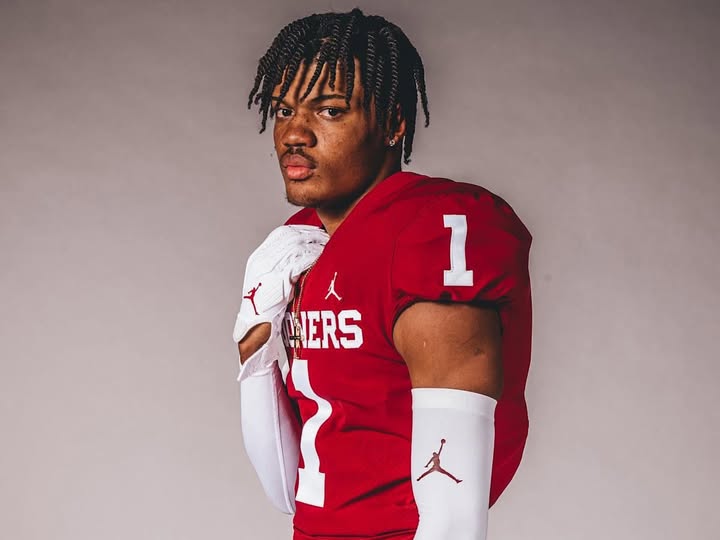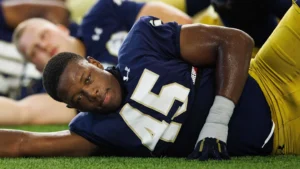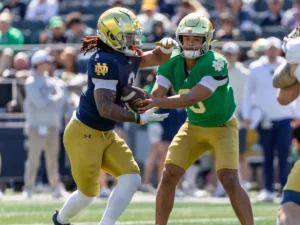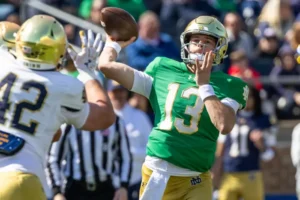
In the ever-shifting world of college football recruiting, surprises are part of the game. Commitments are made, decommitments follow, and elite prospects weigh their futures amid a whirlwind of promises, pitches, and projections. But even by the wild standards of the modern recruiting landscape, Jayden Gibson’s decision to flip his commitment from Oklahoma to Alabama sent shockwaves across the college football world.
The five-star wide receiver — a dynamic, game-breaking talent with size, speed, and swagger — had long been seen as a key piece in Oklahoma’s future plans. With the Sooners transitioning into the SEC and building toward a new era under head coach Brent Venables, Gibson’s pledge was both symbolic and strategic. Yet, in a dramatic twist, Gibson backed off his commitment just weeks before National Signing Day and announced he would instead take his talents to Tuscaloosa.
Alabama Reloads — Again
For Alabama, it’s another massive win on the recruiting trail. Even with Nick Saban retired and former offensive coordinator Kalen DeBoer now at the helm, the Crimson Tide haven’t skipped a beat. Landing a prospect of Gibson’s caliber — particularly in a heated battle with SEC rivals LSU and Tennessee — is a statement that Alabama is still Alabama.
Standing 6-foot-5 and weighing 195 pounds, Gibson is everything modern offenses crave in a No. 1 wide receiver. He stretches the field vertically, dominates in contested catch situations, and runs crisp routes with deceptive quickness. He’s not just a red-zone threat — he’s a every-zone threat.
Alabama’s offense, known for churning out first-round receivers like DeVonta Smith, Jaylen Waddle, Jerry Jeudy, and Jameson Williams, now gets its next great playmaker. For Gibson, the Crimson Tide offer a proven path to the NFL and a chance to compete for national championships from day one.
The Flip Heard Around the SEC
Gibson’s original commitment to Oklahoma came with plenty of fanfare. He cited the Sooners’ vision, their offensive legacy, and a strong relationship with position coaches. But as the months passed, whispers of other suitors creeping back into the race grew louder. Tennessee made a strong push, highlighting its explosive Josh Heupel-led offense and its recent success with wide receivers like Jalin Hyatt. LSU, too, leaned heavily into its wide receiver pedigree — Odell Beckham Jr., Justin Jefferson, Ja’Marr Chase — and the promise of immediate playing time.
But Alabama’s pitch hit differently.
According to sources close to Gibson, the Crimson Tide emphasized more than just scheme and development — they focused on legacy. They painted a picture of Gibson stepping into the next generation of “Wide Receiver U,” donning the iconic crimson and white, and becoming the face of a new era.
By the time Gibson took his official visit to Tuscaloosa, the writing was on the wall. The staff rolled out the red carpet. The facilities, the tradition, the championship rings — it all left a lasting impression. And after some deep family conversations and late-night deliberations, Gibson made his move.
Why Gibson Chose Alabama
In his official statement, Gibson kept things respectful but clear.
“I want to thank the Oklahoma coaching staff and fans for believing in me and showing love throughout this process. It’s never easy making decisions like this, but after much prayer and thought with my family, I’ve decided to flip my commitment and sign with the University of Alabama. I believe in what they’re building, and I’m excited to be part of it.”
Behind the scenes, several factors weighed into the flip:
- NFL Development Track: Alabama has become the gold standard for sending wide receivers to the league. For a player like Gibson with clear professional aspirations, the Tide’s track record was hard to ignore.
- Offensive Fit: Under Kalen DeBoer and his staff, Alabama is expected to run a more modern, pass-friendly scheme that will showcase Gibson’s strengths. The opportunity to be a WR1 in that system was enticing.
- Competition and Culture: Gibson relishes competition. At Alabama, he’ll be pushed every day in practice, sharpened by elite defensive backs and surrounded by a room full of future pros. That level of competition was appealing.
- Brand and Exposure: Simply put, playing for Alabama means being on national television nearly every week. It means prime-time games, playoff implications, and millions of eyeballs — all of which help boost a player’s profile.
What It Means for Alabama
Landing Gibson solidifies Alabama’s 2025 recruiting class as one of the nation’s best. He immediately becomes one of its crown jewels and a future focal point in the offense.
The Crimson Tide have quietly built a loaded receiving corps for the future, combining elite size, speed, and versatility. Gibson joins fellow blue-chip prospects in what looks like a reloaded offensive arsenal for years to come.
Beyond talent, though, Gibson’s commitment is symbolic. It shows that Alabama is still pulling the top dogs from other major programs — and still winning head-to-head battles against fellow SEC powerhouses.
What It Means for Oklahoma
There’s no sugarcoating it: losing Gibson is a gut punch for Oklahoma. He was one of their top commits, a headliner of their transition into the SEC, and a player they expected to build around.
However, recruiting is often about how programs respond. The Sooners still have a solid receiver class and could pivot quickly to other targets, or hit the portal to fill the void.
Brent Venables and his staff have made strides in bringing energy and direction to the program, but losing a player of Gibson’s caliber this late in the cycle raises tough questions about closing power against the SEC’s elite.
What Could Have Been: Tennessee and LSU Left Waiting
For Tennessee, Gibson represented a potential game-changer. With Nico Iamaleava emerging as a star quarterback, the Vols hoped to pair him with an elite pass-catcher like Gibson to take their offense to the next level.
Josh Heupel’s staff was reportedly in regular contact with Gibson right up until his decision, offering a clear path to early playing time and emphasizing the family atmosphere in Knoxville. But it wasn’t enough.
LSU, meanwhile, made an aggressive late push as well. The Tigers’ history with receivers — coupled with their SEC stature and recent recruiting success — made them a legitimate contender. Brian Kelly and staff emphasized how Gibson could follow in the footsteps of Chase, Jefferson, and other Tiger legends.
In the end, though, Alabama’s prestige, development pipeline, and culture proved too strong.
A Star in the Making
Make no mistake: Jayden Gibson isn’t just another blue-chip name. He’s a potential program-defining player. His high school tape is filled with highlights that look like something out of a video game — leaping over defenders, outrunning entire secondaries, and hauling in impossible catches with grace.
Beyond the physical tools, those close to him speak highly of his work ethic, humility, and leadership. Coaches rave about his film study habits and his desire to keep improving, even when he’s already the best player on the field.
He arrives at Alabama with sky-high expectations — and every indication that he’ll live up to them.
The Future Is Crimson
For Alabama fans, the news of Gibson’s flip feels like a return to form. After the brief uncertainty that followed Saban’s retirement, the Tide are once again flexing their muscles on the recruiting trail. The machine rolls on.
For Gibson, the journey is just beginning. He’ll step onto campus with the weight of expectations, the opportunity of a lifetime, and a jersey number that will soon be worn by thousands of fans across the South.





